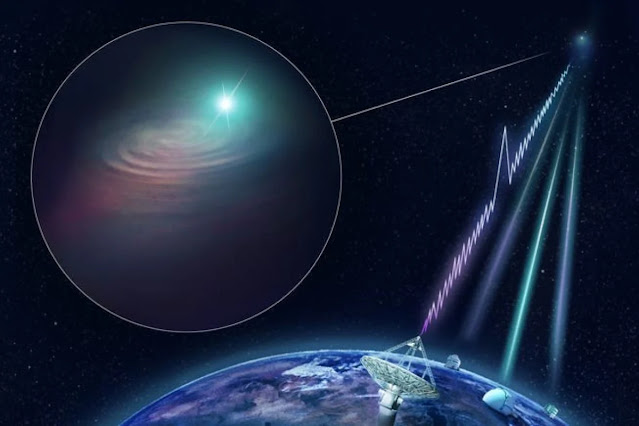 |
| Photo: CSIRO/Andrew Howells |
Scientists recently discovered an incredible new space signal with a repeating pattern and deep space origin, which challenges classic thinking on the cosmic events. The mysterious pattern has challenged investigators to identify its source and what it could mean to their understanding of the universe.
The Findings: Fast Radio Bursts (FRBs)
It is a member of a class of cosmic phenomena known as Fast Radio Bursts, or FRBs. These are brief but powerful bursts of radio waves, typically only a few milliseconds long, which originate from outside our galaxy. The first FRB was detected in 2007; since then, dozens have been discovered, but most have emitted only once. The origins of FRBs are still unknown, several theories point to neutron stars, black holes, and even extraterrestrial technology.
One of the important differences of this new FRB is that it is periodic. Dubbed FRB 180916.J0158+65, it was first seen by the Canadian Hydrogen Intensity Mapping Experiment, or CHIME, a radio telescope specifically designed to detect FRBs. Months of observation made scientists get a really close-up view of this new-found object- except they noticed this pattern: the burst repeats itself every 16.35 days. The periodic nature of this signal is the first of its kind and has scientists scrambling to understand what might be causing such a rhythmic signal from the far reaches of space.
Where in the Universe Is the Signal Coming From?
The repeating signal was traced to a distant galaxy, roughly 500 million light-years away from Earth-considerably short in cosmic distances. The galaxy would appear to be of intermediate size, and the progenitor of the FRB is speculated to be located in a star-forming region of the galaxy. This is interesting because many theories regarding FRBs result from extremely energetic stellar objects, neutron stars or magnetars, which could reasonably plausibly exist in such regions.
Yet the object or mechanism that produces these radio bursts is not known. Many suppose that because the signal is periodic, the source must be some form of a binary system—where one star in the system is a neutron star, emitting the bursts as it interacts with its companion star. This is still speculative.
Why Every 16 Days?
One mystery is this cycle of 16 days in radio bursts. Non-repeating FRBs are essentially one-off cosmic events. But a repeating burst with a fixed interval suggests that something cyclical is happening. Some of the possible theories scientists are considering are:
Orbits a Neutron Star or Black Hole A very much more believable assumption is that the source might orbit around some sort of large object-neutron star, or even a black hole. In this model, the 16-day period corresponds to an orbital time for the object, and the bursts happen whenever the situation becomes appropriate to yield an emission which manages to leak out.
Pulsar-Like Activity: Maybe the source could be a pulsar: a rotating neutron star emitting beams of radiation. The burst may be related to the rotation or interaction with other nearby cosmic objects of the star itself, which causes it to, at times, emit radio waves.
Stellar Wind Interference: There's even the theory that stellar winds from a companion star might interfere with the FRB signal. These winds might block the FRB signal through part of the orbit, and it only could transmit to Earth in restricted time intervals, which explains its occurrence at a regular 16-day cycle.
Alien Technology?
Indeed, with an unusual phenomenon of such a nature, one tends to remember that there exists speculation about extraterrestrial intelligence. The majority of scientists, however, maintain caution and hesitate to jump to conclusions. While the periodic pattern may resemble some making by intelligent civilization, most of the researchers believe that it might be explained on purely astrophysical grounds. One of the several options considered by researchers is the alien involvement though very improbable.
What makes this signal different?
Beyond the predictable nature of this signal lies its significance in new questions it raises about FRBs in general. In the case of FRB 180916.J0158+65, scientists are now offered the chance to observe these bursts over time and perhaps to get a partial idea about their origin and operation mechanisms. Since most FRBs detected until now occurred as one-time or random events, this is quite a rare window of going behind the scenes of cosmic flashes.
This FRB is also the closest observed to Earth, so scientists can get a more detailed view of its characteristics. By deciphering the cause of this 16-day cycle, science may soon be able to crack open some new understandings of high-energy astrophysical phenomena happening across the universe.
What's Next?
Researchers now watch FRB 180916.J0158+65, continue to take more data for each of its cycles. Telescopes worldwide, CHIME and many more, stand on high alert, ready to capture more signals and further refine models that can explain their origin.
More importantly, scientists are now looking for other similar repeating FRBs. If other repeating patterns are found, it may be used to fine-tune existing theories or even point to a completely new class of cosmic object.
A Window to the Unknown
This detection of a 16-day periodic radio signal is a very exciting milestone in the realm of astrophysics. Scientists may eventually dig up new cosmic phenomena or discover that the universe behaves in ways previously unimaginable as they try to understand the origin of FRBs.
The mystery of FRB 180916.J0158+65 still remains undisclosed. Still, searches will not come to an end in understanding these mysterious radio bursts in the immediate future. Whether it is a neutron star or black hole or something as unknown as it might be, this reminds us that space holds something which is unexpected and yet within the universe, it will hold many secrets.




0 Comments